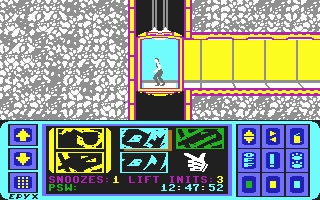Classic Games Emulation | News | Systems | Emulation | Emulators | Games | Links
Impossible Mission
The story behind Impossible Mission is that a mad scientist and recluse named Elvin Atombender is planning to destroy the world. (The story of why Elvin wants to destroy the world has to do with a power outage occurring in the middle of his record breaking run in the video game Giggling Penguin Invaders From Outer Space In The Vicinity Of Ursa Minor.) After the failure of all previous agents, the player is being sent to Elvin's secret underground hideout to try to stop him. In order to do so, he must recover dozens of puzzle pieces from among Elvin's furniture (that's right), and then assemble them into multitudinous four piece puzzles using his PDA. Once all the puzzles are completed, he will be able to gain access to the main control room and stop Elvin.
The story may be rather campy, but Impossible Mission's gameplay is rather unique. The player must move through Elvin's stronghold by using the several elevator shafts running through it. But the shafts are only connected through rooms in which the puzzle pieces can be found. The player must search all (or at least most) of the pieces of furniture, many of which contain no puzzle pieces or passwords. All the while, the player must avoid deadly robots and those dreadful holes in the floors. When all the pieces have been found, the game play changes from action to thinking. Pieces must be rotated, flipped, and color changed before they fit together, and then the completed puzzles must be similarly manipulated. The game takes place in real time, with a six-hour time limit, from which 5 minutes are subtracted every time the player dies.
 |
 |
Trying to avoid the robots while searching through furniture is in itself unique enough among action gameplay to distinguish Impossible Mission. There are several different kinds of robots, each with their own characteristics and behaviors. All robots look the same (except for orbs), so the only way to tell one robot type from another is to observe its behavior. Some dumbly patrol a platform, neither seeing nor hearing intruders, but only providing one more obstacle to avoid. Some can see, and will charge the player as soon as they see him. Others can see and hear, and they will track the player from anywhere in the room. Some fire electrical discharges. Often the only way to get around some of these robots is to sneak up behind them and wait until the robot has moved to the end of its patrol area. When it turns around, a well timed jump will safely carry the player over the robot before it has a chance to respond. And the player must search furniture while being pursued by these devious beings. Altogether, the action elements are quite challenging.

Impossible Mission was one of the more immersive and environmentally effective Commodore 64 games. When playing it, I almost felt like I really was alone in an underground compound, especially when in the elevator shafts; the echo effect in the shafts particularly enhances the effect. And throughout the game, the only thing the player hears is his own foot falls, the whine of the elevators, the warble of the robots, and, occassionally, the PDA. Lonely, indeed.
In the end, though, I think that much of Impossible Mission's appeal consists of its
hybrid gameplay: A player must not
only be adept at action gaming but also puzzle solving, thus greatly expanding the game's
difficulty, but also its interest. I doubt Impossible Mission would have been nearly as
popular if the puzzles had been omitted. They constitute a large part of the game in terms
of time, difficulty, and feel. But the game's action adds needed urgency to its pace and
excitement to its gameplay. ![]()
About CGE (including contact information)
Created April 16, 1998. Last updated March 22, 1999.